Reheating the Global Warming Debate

Prior to the last ice age..... all years are BC/BCE
There were people and dogs.
| -31,000 | Ice Sheets Grow |
| -31,000 | A shift from a wet period to a dryer one some 33,000 years ago may have disrupted the Ostrich eggshell bead trade zone network |
| -31,000 | Aurignacian Culture Subsumed |
| -31,000 | Red Lady of Paviland - 20 year old male found in a cave on the Gower Peninsula in Wales by Rev Buckland - Mammoth hunter |
| -31,000 | Ostrich eggshell bead trade zone - Southern Africa to Eastern Africa (1800 miles) - 48,000 BC to 31,000 BC |
| -31,000 | In 2020, the nuclear genome was generated of a 33,000 YBP Pleistocene wolf from an archaeological site on the Yana River, arctic northeastern Siberia. The Yana wolf sequence was more closely related to the 35,000 YBP Taimyr wolf than it was to modern wolves. There was evidence of gene flow between the Yana-Taimyr wolves and the Pre-Columbian, Zhokhov, and modern sled dogs. This suggests that genetic admixture has occurred between the Pleistocene wolves and the ancestor of these dogs. There was no evidence of admixture between sled dogs and the modern grey wolf for the past 9,500 years. |
| -30,000 | Dog domestication |
| -30,000 | The Zhokhov study proposes that after having diverged from the common ancestor shared with the grey wolf, the evolution of the dog proceeded in three stages. The first was natural selection based on feeding behavior within the ecological niche that had been formed through human activity. The second was artificial selection based on tamability. The third was directed selection based on forming breeds that possessed qualities to help with specific tasks within the human economy. The process commenced 30,000–40,000 YBP with its speed increasing in each stage until domestication became complete. |
| -30,000 | Earlier in 2018, a study proposes that the Yana site showed evidence of wolf pre-domestication. There are remains of medium-sized canids found there that could not be referred to as dogs, however they showed indications of living with people. These included worn and partially-missing teeth, and the skull of an almost-adult showing juvenile features. The morphologic and morphometric anomalies in the specimens indicate commensalism and the earliest stage of domestication. |
| -30,000 | The ancient North Siberians were once a people whose ancestors archaeological remains have been found at the Paleolithic Yana RHS (Rhinoceros Horn Site) on the Yana River delta in arctic northern Siberia that is dated 31,600 YBP, and at the Mal’ta site near Lake Baikal in southern Siberia just north of Mongolia that is dated 24,000 YBP. Ancient dog remains dating to this time and place have yet to be discovered to support this hypothesis.[12] |
| -30,000 | Polished Stone Axes of Nagano |
| -30,000 | Mortar and Pestle Used for Grinding Oats - Grotto Paglicci in South Italy |
| -30,000 | Oats, Acorns, Millet, Bulrushes - heated, dried, ground, hydrated, cooked. - Food Processing |
| -30,000 | Rise of the Gravettian Culture across Europe |
| -28,000 | Beringia exposed |
| -28,000 | Aurignacian-Perigordian cave drawings of people being pierced by arrows |
| -28,000 | Aurignacian Culture of Europe - Spain to Crimea - subsumed |
| -28,000 | Caldey Island off Wales - paleolithic hunters feeding off of terrestrial game |
| -28,000 | Traces of Paleolithic culture, mainly stone tools, occur in Japan from around 30 000 BP onwards. |
| -28,000 | The earliest "Incipient Jōmon" phase began while Japan was still linked to continental Asia as a narrow peninsula. |
| -28,000 | Bear Spirit Mountain - W. Virginia - 28,000 to 13,000 BC |
| -28,000 | Sauce, Uruguay |
| -28,000 | Spears and Stone tools found at 65 degrees north on the Yana Rivers in Siberia |
| -28,000 | Einkorn harvesting from the wild at Tell Qaramel in N. Syria starts genetic selection process |
| -28,000 | Hohle Fels Polished Stone Dildo/Pestle |
| -27,000 | 23,000 year wobble - Apsidal and Axial precession - Green Sahara to Dry |
| -27,000 | Scottish Ice Advance |
| -27,000 | Dolne Vestonice Nets |
| -26,000 | Cro-Magnon of Southern Italy genetically distinct from Neanderthal and identical to modern humans |
| -25,000 | Cosquer Cave France - Hand Stencils |
| -25,000 | Dolne Vestonice Weaving |
| -25,000 | Dolne Vestonice - At an isolated site 80 meters upstream lies a lean-to shelter dug into an embankment an estimated 2,300 clay figurines of various animals were found in and around the remains of a kiln - one of the first instances of a covered oven, hot enough to fire clay. |
| -25,000 | Dolne Vestonice Ceramics - Gravettian period, which spanned roughly 27,000 to 20,000 B.C |
| -24,500 | Wuerm - Last Glacial Maximum |
| -24,000 | Neanderthal Extinction Glaciation |


The Neanderthals didn't survive the event but we did.
The Mammoth Bone Wigwam was similar to those found at Dolne Vestonice in Slovakia dated to about 27,000 years ago, at the height of the last ice age. Those people also had the technology to create the multimodal transport employed by the Inuit in the pre-Skidoo days. Their movement was slowed down when the ice disappeared and they were forced to walk on muddy grass and dodge ponds, lakes and rivers.
Dogs take you, your sled and your boat upstream over the ice. You sell or eat the dogs. Take pups back down river with you in your kayak in the spring.
| -24,000 | Peña Capón rock shelter in Guadalajara province, Spain on the banks of the Sorbe River material remains attributed to hunter-gatherers who had inhabited the region 26 100 to 23 800 years ago. The rock shelter was used seasonally by these Solutrean and Proto-Solutrean groups of Homo sapiens for hunting and processing prey. |
| -24,000 | Homo sapiens hunter-gatherers did not avoid the interior region, even during the Heinrich Stadial 2, one of the coldest periods of the last ice age. |
| -24,000 | Hunter-gatherers entered the Iberian interior and settled there at least during Solutrean times, around 25,000 to 20,000 years ago. |
| -24,000 | Mammoths butchered on Kotelny Island in Siberian Arctic |
| -24,000 | Rise of the Solutrean Culture |
| -23,000 | Northern Eurasians interbreed with the East Asian ancestors of modern Native Americans in North-East Siberia |
| -23,000 | Amerindian mtDNA is found only in mtDNA haplogroups A2a, A2b, B2, C1b, C1c, C1d, C1d1 D1, D3, D4h3a, D4e1c, and X2a. |
| -23,000 | a common style of stone tool production found across the Americas, |
| -23,000 | utilized by highly mobile bands consisting of approximately 20 to 60 members of an extended family. |
| -23,000 | Family groups moved every 3–6 days, possibly traveling up to 360 km (220 mi) a year. |
| -23,000 | Food would have been plentiful during the few warm months of the year. |
| -23,000 | Lakes and rivers were teeming with many species of fish, birds and aquatic mammals |
| -23,000 | Nuts, berries and edible roots could be found in the forests and marshes. |
| -23,000 | Clothing was made from a variety of animal hides that were also used for shelter construction.[ |
| -23,000 | Yukon, North BC, West AB |
| -23,000 | Old Crow 67N - 38,000 to 23,000 BP |
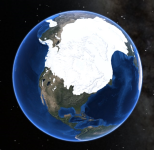
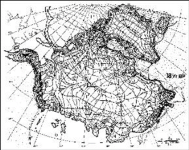
Ice coverage in Canada from about 31000 BC to 16000 BC
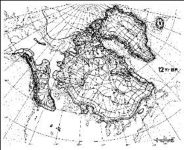

About 12000 years ago, 10,000 BC, global warming exposes the Eastern Slopes of the Rockies but the ice and the edges of the ice preserve an environment similar to that exploited by the Inuit (seal hunters), the Dene (caribou hunters) and the Salmon fishers of the Pacific.
At this time their compatriots were finding it harder going in the Middle East. There they were starting to work on their farming skills and building meeting places with clocks like Gobekli Tepe.
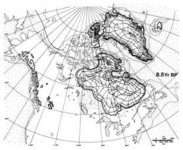
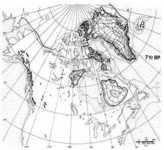
Between 8500 years ago and 5000 years ago warming caused the ice sheet over Hudson Bay to collapse. This raised the water levels drastically separating Eurasia from Britain and flooding the Black Sea. The farmers in the area ran for high ground and eventually found their way to Britain by way of the Danube and the Mediterranean.
When they got there they started farming, raising cattle and building more meeting places and clocks like Stonehenge and the Stones of Stenness, and no doubt employing time keepers and security guards to keep an eye on their meeting places.
This is the same era the Mesopotamians started keeping track of the their beer, barley and slaves by hiring accountants who immediately created clay spread sheets. Shortly thereafter the system was used for writing pornography and other tall tales. The Egyptians started creating an empire and building pyramids.
While this was happening Northern Quebec and the Barrenlands of Nunavut looked a lot like Greenland today. The Eastern Woodlands started to grow and the Algonkian language seems to have risen contemporaneously with the growth of the woodlands.
.....
When did we want Global Warming to stop?



















